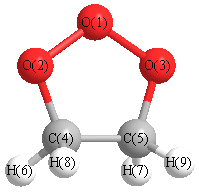Vibrational Frequencies calculated at QCISD(T)/6-31G*
| Mode Number |
Symmetry |
Frequency
(cm-1) |
Scaled Frequency
(cm-1) |
IR Intensities
(km mol-1) |
Raman Act
(Å4/u) |
Dep P |
Dep U |
|---|
| 1 |
A' |
3150 |
3022 |
|
|
|
|
| 2 |
A' |
3076 |
2951 |
|
|
|
|
| 3 |
A' |
1556 |
1493 |
|
|
|
|
| 4 |
A' |
1365 |
1309 |
|
|
|
|
| 5 |
A' |
1253 |
1202 |
|
|
|
|
| 6 |
A' |
1019 |
978 |
|
|
|
|
| 7 |
A' |
955 |
916 |
|
|
|
|
| 8 |
A' |
877 |
841 |
|
|
|
|
| 9 |
A' |
853 |
818 |
|
|
|
|
| 10 |
A' |
689 |
661 |
|
|
|
|
| 11 |
A' |
409 |
393 |
|
|
|
|
| 12 |
A" |
3133 |
3006 |
|
|
|
|
| 13 |
A" |
3066 |
2941 |
|
|
|
|
| 14 |
A" |
1539 |
1476 |
|
|
|
|
| 15 |
A" |
1361 |
1306 |
|
|
|
|
| 16 |
A" |
1240 |
1189 |
|
|
|
|
| 17 |
A" |
1168 |
1121 |
|
|
|
|
| 18 |
A" |
1034 |
992 |
|
|
|
|
| 19 |
A" |
736 |
706 |
|
|
|
|
| 20 |
A" |
667 |
640 |
|
|
|
|
| 21 |
A" |
110 |
105 |
|
|
|
|
Unscaled Zero Point Vibrational Energy (zpe) 14627.9 cm
-1
Scaled (by 0.9593) Zero Point Vibrational Energy (zpe) 14032.5 cm
-1
See section
III.C.1 List or set vibrational scaling factors
to change the scale factors used here.
See section
III.C.2
Calculate a vibrational scaling factor for a given set of molecules
to determine the least squares best scaling factor.
